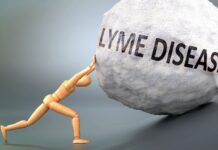
It was about a week before we knew that Covid was coming; a few days prior to Purim of 2020. One Thursday afternoon, my husband suddenly said, “Stop whatever you’re doing and go buy baby formula!” I thought that sounded crazy—we’d never really experienced any major shortages—but he could sense that something was brewing. Moreover, if there was going to be some kind of lockdown, the rest of us would find something to eat, but for my five-month-old baby, formula was all there was.
I remember running to Target and being shocked: the shelves were empty! This was before the toilet paper shortage. Baruch Hashem, I found some formula that day, but I remember the urgency of the search. And although I don’t remember how much I bought and where, I was probably guilty of buying everything I could once I found it.
After Covid hit, if you were unable to locate a product, there was almost always another option. Which is why this most recent shortage of baby formula is the scariest of all.
On May 9, 2022, a photo taken in a local Target went viral. The picture showed the shelves where the baby formula is usually on display stocked with bottled water instead. The photo was taken by a woman named Devorah Silverstein, who wrote, “This picture is not unique. You can find this in almost every city and state in our country. You can also find parents trembling in fear when they realize they will be going home empty-handed while trying to supply basic nutritional needs for their baby. I don’t care what political affiliation you are. Isn’t this relevant? Where is our government? We are in a state of emergency right now. My heart goes out to anyone else who is dealing with this disaster.”
* * *
Evidence of baby formula outages began trickling in at the beginning of this past April. By mid-month, over 30% of the most popular brands were sold out nationwide. By the end of April, the percentage had climbed to over 40%, and the number was only going up. In some parts of the country (including New Jersey and many Midwestern states) the outages are even more drastic, with parents driving for hours to find some. Datasembly, a data analytics firm, collects data from 11,000 stores and has been tracking the diminishing supply.
“The shortages began during Covid, and it has been a struggle ever since,” says Avigdor Weinberger, a production manager for Mehadrin Dairy. “As it has for all other products, difficulty in obtaining ingredients and even packaging, such as the cans in which the formula is sold, have slowed production all over. Over the past eight months, baby formula in particular has been on and off the shelves.”
That’s basically the same challenge that all manufacturers were facing: labor and material shortages, as well as transportation and shipping struggles. But there was still a steady-ish—if slower than usual—supply of baby formula.
“Then Abbott—the maker of Similac, one of the biggest formula manufacturers in the world—had a recall, and one of their plants was shut down by the FDA. That affected the market drastically.”
The Similac Factor
Whenever things are touch and go, it’s hard for any market to sustain a kink. In February, baby formula that had been produced in Abbott’s plant in Sturgis, Michigan, was linked to a number of infant hospitalizations due to a rare bacterial infection. Abbott recalled the powdered formula and the plant was shut down by the FDA after a subsequent inspection. Baby formula—a product we expect to be unquestionably pure and manufactured under the most hygienic of conditions—was being made in a plant that was decidedly unsanitary. The inspectors discovered horrors: surfaces weren’t being cleaned, workers were handling product with their hands, and there was a lack of temperature control. They also found the presence of cronobacter, a type of bacteria that can be fatal to infants if ingested.
In truth, the authorities had found these conditions after eight individual inspections over the past two years—but nothing had been done to rectify them. The sudden shutdown of Abbott’s largest Similac manufacturing plant in the United States left the formula industry reeling from sudden, drastic shortages. (The factory has been permitted to only produce the specialty formula that is unavailable elsewhere for babies with specific dietary needs). Consumers ran to their competitors, leaving other suppliers with an even greater struggle to keep up with demand.
Typically, in a free market, supply and demand help regulate the flow of goods. When supply diminishes, prices go up and fewer people buy the product, but it’s still always available at a price. But whereas with most commodities, prices increase in relation to out-of-stock rates, formula is unique because there is no alternative. If you have a formula-fed baby, you need it at any cost. Baby formula is also in a category of its own because the US government is its biggest consumer, buying almost half of it. Of the 3.6 million babies born in America last year, 1.5 million of them are fed by the government-sponsored WIC program. WIC only approves certain brands of formula to be used through its programs because they buy those cans at heavily subsidized rates.




















